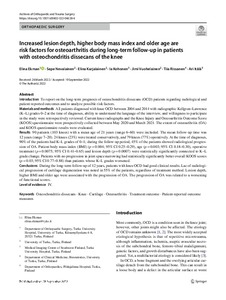Increased lesion depth, higher body mass index and older age are risk factors for osteoarthritis during long-term follow-up in patients with osteochondritis dissecans of the knee
Ekman Elina; Nevalainen Sepe; Karjalainen Elina; Kohonen Ia; Vuohelainen Jimi; Rissanen Tiia; Itälä Ari
https://urn.fi/URN:NBN:fi-fe2022110164066
Tiivistelmä
Introduction To report on the long-term prognosis of osteochondritis dissecans (OCD) patients regarding radiological and patient-reported outcomes and to analyze possible risk factors.
Materials and methods All patients diagnosed with knee OCD between 2004 and 2014 with radiographic Kellgren-Lawrence (K-L) grades 0-2 at the time of diagnoses, ability to understand the language of the interview, and willingness to participate in the study were retrospectively reviewed. Current knee radiographs and the Knee Injury and Osteoarthritis Outcome Score (KOOS) questionnaire were prospectively collected between May 2020 and March 2021. The extent of osteoarthritis (OA) and KOOS questionnaire results were evaluated.
Results 90 patients (103 knees) with a mean age of 21 years (range 6-60) were included. The mean follow-up time was 12 years (range 7-20). 24 knees (23%) were treated conservatively, and 79 knees (77%) operatively. At the time of diagnoses, 90% of the patients had K-L grades of 0-1; during the follow-up period, 45% of the patients showed radiological progression of OA. Patient body mass index (BMI) (p = 0.004; 95% CI 0.25-0.29), age (p = 0.003; 95% CI 0.18-0.30), operative treatment (p = 0.0075; 95% CI 0.41-0.65) and lesion depth (p = 0.0007) were statistically significantly connected to K-L grade change. Patients with no progression in joint space narrowing had statistically significantly better overall KOOS scores (p = 0.03; 95% CI 0.77-0.88) than patients whose K-L grades worsened.
Conclusions During the long-term follow-up of 12 years, patients with knee OCD had good clinical results. Lac of radiological progression of cartilage degeneration was noted in 55% of the patients, regardless of treatment method. Lesion depth, higher BMI and older age were associated with the progression of OA. The progression of OA was related to a worsening of functional scores.
Kokoelmat
- Rinnakkaistallenteet [27094]
